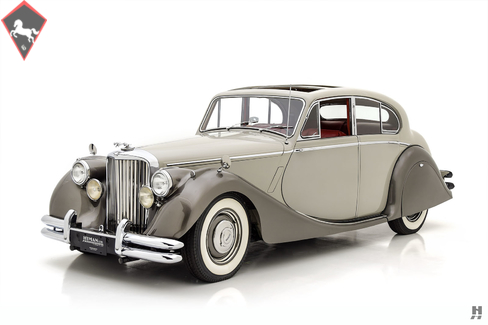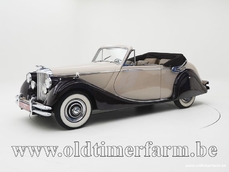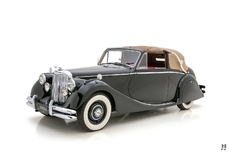Jaguar MkV Saloon 1950
General description :
The Jaguar stand at the 1948 London Motor Show was the source of quite a few milestones for the Sir William Lyon’s still-fledgling car company. History books recall it as the place where the sensational new XK120 made its debut, however the new sports car shared the stand and the limelight with Jaguar’s latest saloon, the Mark V. While the XK120 stole the headlines with its stunning looks and luscious twin-cam inline-six, the Mark V was equally as sophisticated, if just a bit more understated, than its sporting sibling. Most notably, the Mark V was the first all-new Jaguar since the end of World War II. Since it beat the XK120 to production, it was also the first Jaguar to use hydraulic brakes, independent front suspension, pressed steel wheels, and it became the first production car to use sealed ball-joints in the front end; a design that was soon adopted by virtually every major auto manufacturer since. The Mark V featured elegant styling, retaining a traditional English formality while the XK120 hit the streets with its sultry feline aesthetic. Mk V buyers had a choice of either a closed saloon or the equally handsome open drophead-coupe. Power came from either a 2 ½ litre or 3 ½ litre single-cam pushrod inline six-cylinder engine, derived from a Standard unit used in the Mk IV and SS100. The Mark V remained in production for just 28 months, with a touch over 10,000 units built before the updated, XK-powered Mk VII replaced it (skipping the Mk VI moniker because of its use by Bentley). Collectors covet these rare and beautiful Jaguars for their swoopy baroque styling, luxurious accommodations, and sporty road manners. Particularly in 3 ½-litre form, they return excellent performance and in many ways, are akin to a “poor man’s” Bentley Mk VI.
This is a handsome example of the Jaguar Mk V Saloon, in desirable 3 ½-litre specification. Finished in an attractive two-tone combination of dove gray over smoke silver wings, this is a lovely car, wearing a well-maintained older restoration. According to the Jaguar Daimler Heritage Trust, this car is a genuine 3 ½ litre model, delivered new to the United States via the legendary Max Hoffman Imports in New York. The extensive history file shows this car was purchased in the 1970s out of Phoenix, Arizona by John J. Connor of New Jersey. Mr. Connor owned the car for many years, eventually performing a ground up restoration. The Jag had additional restoration work done in the 1990s and has since been lovingly tended to by a series of enthusiast owners. It presents in attractive condition with the glossy paintwork now showing a few touchups and minor imperfections acquired from age and use. Brightwork is excellent, with tidy, straight bumpers and the radiator shell presented with good plating with some light polish marks in the finish. Options and accessories include a factory sunroof, leaper mascot and a pair of Lucas fog lamps. Factory correct pressed steel wheels wear original style wheel covers, fitted with updated wide-whitewall radial tires.
Upholstery consists of beautiful red Connolly hides with red Wilton wool carpets and burl walnut trim, conveying the warm and inviting character in the classic British tradition. The high-quality leather shows some slight creasing on the seating surfaces, particularly in the front seats, which serves to add to the charm and appeal. Matching red door panels are excellent. Extensive wood trim features on the door caps, dash, windscreen surround and even the around sunroof-opening. The finish quality of the woodwork is quite good overall, with a few minor cracks and imperfections found that does little to detract from the otherwise excellent cabin. The wool headlining is outstanding, with matching upholstered sun visors that fit flush against the roof. The coachwork allows plenty of room for four adults, with a generous boot for everyone’s luggage. A hallmark of the Mk V is the extensive tool kit, cleverly hidden within the bottom-hinged boot lid. This car’s tool kit is nearly complete, with excellent quality original tools and correct green flocking in the storage panel.
A period-correct 3 ½-litre inline six resides under the bonnet, fed by a pair of S.U. carburetors as originally fitted. With a useful 125 horsepower on tap, performance is brisk, hinting at Jaguar’s sports saloons of the future. Honestly presented with factory-correct finishes, the engine is appropriately detailed, and it runs well. The inline-six mates to a floor-shifted four-speed manual Moss gearbox which contributes a good deal to the Mk V’s sporting character.
This handsome Jaguar is a usable and desirable example, well-suited to casual touring and club events. The older restoration remains crisp and attractive, and the lush cabin is a beautiful place to spend a day of motoring. Built in relatively low numbers, Jaguar’s beautiful Mk V is an important milestone in the firm’s history, as the first all-new post-war model, and as a precursor to the legendary sporting saloon cars that would soon follow in its wheel tracks.
https://hymanltd.com/vehicles/6384
1950 Jaguar MkV Saloon is listed sold on ClassicDigest in St. Louis by Mark Hyman for $49500.
Car Facts
Car type : Car Make : Jaguar Model : MkV Model Version : Saloon Engine size : 0.0 Model Year : 1950 Sub type : Sedan Location : Missouri
Sold
Seller Information
Sold
People who viewed this Jaguar MkV also viewed similar Jaguar listed at ClassicDigest
Other cars listed for sale by this dealer
About Jaguar
Ah, the story of Jaguar, from its early days as the SS Cars Ltd. to its pinnacle with the D-type, and the street-going evolution in the form of the iconic E-type. There's something quintessentially British about this tale, and I'll narrate it as a British journalist might.In the Beginnings:
Our journey into the world of Jaguar begins in the 1930s, when a company known as SS Cars Ltd. emerged. Despite the unfortunate coincidence of their initials with the rising political tensions in Europe, they started producing stylish and performance-oriented cars. The SS 100, introduced in 1936, was a symbol of elegance and speed, setting the stage for what would become Jaguar.
The Birth of Jaguar:
As the shadows of World War II loomed, SS Cars Ltd. wisely decided to disassociate themselves from the SS initials. Thus, in 1945, they officially became Jaguar Cars Ltd., a name that would soon be synonymous with British luxury and performance.
The XK Series:
Jaguar's post-war era brought us the XK 120, a true sensation in 1948. With its sleek design and a powerful 3.4-liter inline-six engine, it became the world's fastest production car. The XK 120 was the blueprint for what lay ahead – Jaguars that blended style with speed in a uniquely British fashion.
The D-type Dominance:
Then came the D-type, a true racing legend. Introduced in 1954, it won Le Mans three times in the 1950s, showcasing Jaguar's engineering prowess. With its innovative monocoque construction and the iconic fin at the back, the D-type was the apex of Jaguar's motorsport success.
The E-type Emergence:
But the true turning point arrived in 1961 with the introduction of the E-type, often described by Enzo Ferrari as "the most beautiful car ever made." Its long bonnet, curvaceous body, and a 3.8-liter engine delivering exhilarating performance made it an instant classic. The E-type was not just a car; it was a work of art on wheels, and it could hit 150 mph on the road.
Street and Racing Success:
The E-type's beauty was matched by its capability on the track. The lightweight E-types were particularly successful in various racing events, cementing Jaguar's reputation as a force to be reckoned with in motorsport.
The Age of Refinement:
As we delve deeper into the Jaguar story, we find that the 1950s and 1960s were an age of refinement and expansion. Alongside the magnificent D-type and the E-type's iconic emergence, Jaguar introduced models that further solidified its reputation for luxury and performance.
The MK2:
In the late 1950s, Jaguar unveiled the MK2, a sports sedan that combined elegance with power. This sleek four-door saloon was a favorite of bank robbers and law enforcement alike, thanks to its exceptional speed and handling. The MK2 was a symbol of Jaguar's ability to blend sophistication with performance and had a successful racing career as well.
The XJ6:
Fast forward to 1968, and Jaguar launched a car that would define luxury saloons for decades to come – the XJ6. It was a masterpiece of engineering and design, featuring a smooth inline-six engine, independent rear suspension, and a spacious, beautifully appointed interior. The XJ6 was a symbol of British elegance and provided a ride so smooth that it seemed to glide over the road. It became the flagship model for Jaguar and set the standard for luxury saloons, showcasing a level of refinement that left competitors in awe.
The Blend of Classic and Modern:
While the MK2 and XJ6 represented the evolution of Jaguar's saloon cars, they maintained the brand's commitment to performance and luxury. These cars didn't just belong on the racetrack; they were equally at home cruising down the grand boulevards or gliding through the English countryside.
The Challenges of Change:
However, as the 1970s arrived, Jaguar, like many British automakers, faced financial challenges and changes in ownership. The British Leyland era brought both opportunities and struggles, as the brand navigated through various mergers and transitions.
Nevertheless, the legacy of the MK2 and XJ6, along with the D-type and E-type, continues to define Jaguar as a manufacturer that combines timeless elegance with a spirit of performance. These classic models, whether driven on winding roads or parked as collectors' treasures, serve as a testament to Jaguar's enduring presence in the world of automotive excellence.
The Jaguar story, from its early days as SS Cars Ltd. to the creation of automotive icons like the E-type, MK2, and XJ6, is a journey that reflects the very essence of British motoring – a blend of luxury, power, and style that continues to captivate enthusiasts and connoisseurs alike.











